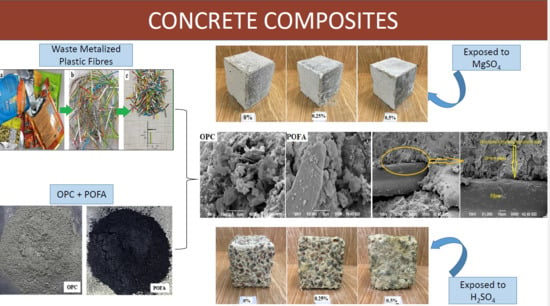Enhanced Performance of Concrete Composites Comprising Waste Metalised Polypropylene Fibres Exposed to Aggressive Environments
Abstract
:1. Introduction
2. Experimental Program
2.1. Materials
2.2. Mix Proportions
2.3. Production of Specimens
3. Results and Discussion
3.1. Workability
3.2. Compressive Strength of Water-Cured Specimens
3.3. Sulphate Resistance
3.3.1. Visual Inspection
3.3.2. Mass Gain
3.3.3. Residual Compressive Strength
3.4. Acid Resistance
3.4.1. Visual Inspection
3.4.2. Mass Loss
3.4.3. Residual Strength
4. Conclusions
- (1)
- The inclusion of WMP fibre reduced the workability of all concrete mixes, with lower slump values and higher VeBe times compared with those of the plain mix.
- (2)
- The cube compressive strength of water-cured specimens was reduced by adding WMP fibres. However, the compressive strength significantly developed with the presence of POFA after 365 days.
- (3)
- In sulphate solution, enhanced performance in the resistance of concrete mixes to sulphate attacks was attained by utilising WMP fibres and POFA. The main consequence of fibres was attributed to the formation of the grid structure to avoid the entering of destructive particles into the matrix and crack formation. Besides, the lower rate of mass gain and strength losses against sulphate attacks were detected for reinforced mixes.
- (4)
- A satisfactory level of resistance to the sulphuric acid attacks was observed for the fibre reinforced specimens. The primary effect of POFA was attributed to the dilution effect of pastes owing to the replacement of OPC by POFA, which decreased the existing amount of Ca(OH)2 content for reaction with acid and formation of gypsum. Besides, lower mass and strength losses were noted for the mixes containing POFA and WMP fibres.
- (5)
- The microstructural analysis of paste specimens revealed changes in the nature of hydration products as a result of acid and sulphate attacks. However, the POFA-based specimens performed better against chemical attacks compared with those of OPC mixes owing to the development of supplementary C-S-H gels as a result of the pozzolanic reaction, which filled up the voids in the matrix and provided a denser microstructure. It, therefore, enhanced the performance of concrete in terms of strength and durability under chemical attacks.
- (6)
- The utilisation of plastic waste fibres and POFA has potential in retaining the integrity of the concrete matrix under chemical attacks. Additionally, conservation of waste materials and lower environmental contamination would also be achieved.
Author Contributions
Funding
Acknowledgments
Conflicts of Interest
References
- Mohammadhosseini, H.; Tahir, M.M.; Alyousef, R.; Alabduljabbar, H.; Samadi, M. Effect of elevated temperatures on properties of sustainable concrete composites incorporating waste metalized plastic fibres. SN Appl. 2019, 1, 1520. [Google Scholar] [CrossRef] [Green Version]
- Prem, P.R.; Verma, M.; Ambily, P.S. Sustainable cleaner production of concrete with high volume copper slag. J. Clean. Prod. 2018, 193, 43–58. [Google Scholar] [CrossRef]
- Abdel-Gawwad, H.A.; Rashad, A.M.; Heikal, M. Sustainable utilisation of pretreated concrete waste in the production of one-part alkali-activated cement. J. Clean. Prod. 2019, 232, 318–328. [Google Scholar] [CrossRef]
- Evi Aprianti, S. A huge number of artificial waste material can be supplementary cementitious material (SCM) for concrete production e a review part II. J. Clean. Prod. 2017, 142, 4178–4194. [Google Scholar] [CrossRef]
- Jittin, V.; Bahurudeen, A.; Ajinkya, S.D. Utilisation of rice husk ash for cleaner production of different construction products. J. Clean. Prod. 2020, 263, 121578. [Google Scholar] [CrossRef]
- Gu, L.; Ozbakkaloglu, T. Use of recycled plastics in concrete: A critical review. Waste Manag. 2016, 51, 19–42. [Google Scholar] [CrossRef]
- Aryan, Y.; Yadav, P.; Samadder, S.R. Life Cycle Assessment of the existing and proposed plastic waste management options in India: A case study. J. Clean. Prod. 2019, 211, 1268–1283. [Google Scholar] [CrossRef]
- Longo, F.; Cascardi, A.; Lassandro, P.; Sannino, A.; Aiello, M.A. Mechanical and thermal characterisation of FRCM-Matrices. Key Eng. Mater. 2019, 817, 189–194. [Google Scholar] [CrossRef]
- Bhogayata, A.C.; Arora, N.K. Fresh and strength properties of concrete reinforced with metalized plastic waste fibres. Constr. Build. Mater. 2017, 146, 455–463. [Google Scholar] [CrossRef]
- Bhogayata, A.C.; Arora, N.K. Impact strength, permeability and chemical resistance of concrete reinforced with metalized plastic waste fibres. Constr. Build. Mater. 2018, 161, 254–266. [Google Scholar] [CrossRef]
- Khankhaje, E.; Hussin, M.W.; Mirza, J.; Rafieizonooz, M.; Salim, M.R.; Siong, H.C.; Warid, M.N.M. On blended cement and geopolymer concretes containing palm oil fuel ash. Mater. Des. 2016, 89, 385–398. [Google Scholar] [CrossRef]
- Lim, N.H.A.S.; Mohammadhosseini, H.; Tahir, M.M.; Samadi, M.; Sam, A.R.M. Microstructure and strength properties of mortar containing waste ceramic nanoparticles. Arab. J. Sci. Eng. 2018, 43, 5305–5313. [Google Scholar] [CrossRef]
- Mastali, M.; Dalvand, A.; Sattarifard, A. The impact resistance and mechanical properties of the reinforced self-compacting concrete incorporating recycled CFRP fibre with different lengths and dosages. Compos. Part B Eng. 2017, 112, 74–92. [Google Scholar] [CrossRef]
- Brown, P.W.; Badger, S. The distributions of bound sulfates and chlorides in concrete subjected to mixed NaCl, MgSO4, Na2SO4 attack. Cem. Concr. Res. 2000, 30, 1535–1542. [Google Scholar] [CrossRef]
- Santhanam, M.; Cohen, M.; Olek, J. Differentiating seawater and groundwater sulfate attack in Portland cement mortars. Cem. Concr. Res. 2006, 36, 2132–2137. [Google Scholar] [CrossRef]
- Bulatović, V.; Melešev, M.; Radeka, M.; Radonjanin, V.; Lukić, I. Evaluation of sulfate resistance of concrete with recycled and natural aggregates. Constr. Build. Mater. 2017, 152, 614–631. [Google Scholar] [CrossRef]
- Sotiriadis, K.; Nikolopoulou, E.; Tsivilis, S. Sulfate resistance of limestone cement concrete exposed to combined chloride and sulfate environment at low temperature. Cem. Concr. Compos. 2012, 34, 903–910. [Google Scholar] [CrossRef]
- Monteny, J.; Vincke, E.; Beeldens, A.; De Belie, N.; Taerwe, L.; Van Gemert, D.; Verstraete, W. Chemical, microbiological, and in situ test methods for biogenic sulfuric acid corrosion of concrete. Cem. Concr. Res. 2000, 30, 623–634. [Google Scholar] [CrossRef]
- Palankar, N.; Shankar, A.U.R.; Mithun, B.M. Durability studies on eco-friendly concrete mixes incorporating steel slag as coarse aggregates. J. Clean. Prod. 2016, 129, 437–448. [Google Scholar] [CrossRef]
- Afroughsabet, V.; Biolzi, L.; Ozbakkaloglu, T. High-performance fibre-reinforced concrete: A review. J. Mater. Sci. 2016, 51, 6517–6551. [Google Scholar] [CrossRef] [Green Version]
- Mastali, M.; Dalvand, A. The impact resistance and mechanical properties of self-compacting concrete reinforced with recycled CFRP pieces. Compos. Part B Eng. 2016, 92, 360–376. [Google Scholar] [CrossRef]
- Ranjbar, N.; Behnia, A.; Alsubari, B.; Birgani, P.M.; Jumaat, M.Z. Durability and mechanical properties of self-compacting concrete incorporating palm oil fuel ash. J. Clean. Prod. 2016, 112, 723–730. [Google Scholar] [CrossRef]
- Hossain, M.M.; Karim, M.R.; Hasan, M.; Hossain, M.K.; Zain, M.F.M. Durability of mortar and concrete made up of pozzolans as a partial replacement of cement: A review. Constr. Build. Mater. 2016, 116, 128–140. [Google Scholar] [CrossRef]
- Zollo, R.F. Fibre-reinforced concrete: An overview after 30 years of development. Cem. Concr. Compos. 1997, 19, 107–122. [Google Scholar] [CrossRef]
- Sideris, K.K.; Savva, A.E.; Papayianni, J. Sulfate resistance and carbonation of plain and blended cements. Cem. Concr. Compos. 2006, 28, 47–56. [Google Scholar] [CrossRef]
- Rahman, M.R.; Hamdan, S.; Jayamani, E.; Kakar, A.; Bakri, M.K.B.; Yusof, F.A.B.M. The effect of palm oil fuel ash (POFA) and polyvinyl alcohol (PVA) on the physico-mechanical, thermal and morphological properties of hybrid bio-composites. Polym. Bull. 2019, 77, 3523–3535. [Google Scholar] [CrossRef]
- Salami, B.A.; Johari, M.A.M.; Ahmad, Z.A.; Maslehuddin, M. Durability performance of palm oil fuel ash-based engineered alkaline-activated cementitious composite (POFA-EACC) mortar in sulfate environment. Constr. Build. Mater. 2017, 131, 229–244. [Google Scholar] [CrossRef]
- Awal, A.S.M.A.; Mohammadhosseini, H. Green concrete production incorporating waste carpet fibre and palm oil fuel ash. J. Clean. Prod. 2016, 137, 157–166. [Google Scholar] [CrossRef]
- Medina, N.; Barluenga, G.; Hernández-Olivares, F. Enhancement of durability of concrete composites containing natural pozzolans blended cement through the use of Polypropylene fibres. Compos. Part B Eng. 2014, 61, 214–221. [Google Scholar] [CrossRef]
- Zuquan, J.; Wei, S.; Yunsheng, Z.; Jinyang, J.; Jianzhong, L. Interaction between sulfate and chloride solution attack of concretes with and without fly ash. Cem. Concr. Res. 2007, 37, 1223–1232. [Google Scholar] [CrossRef]
- Söylev, T.A.; Özturan, T. Durability, physical and mechanical properties of fibre-reinforced concretes at low-volume fraction. Constr. Build. Mater. 2014, 73, 67–75. [Google Scholar] [CrossRef]
- Mohammadhosseini, H.; Tahir, M.M.; Alaskar, A.; Alabduljabbar, H.; Alyousef, R. Enhancement of strength and transport properties of a novel preplaced aggregate fiber reinforced concrete by adding waste polypropylene carpet fibers. J. Build. Eng. 2020, 27, 101003. [Google Scholar] [CrossRef]
- Alyousef, R.; Alabduljabbar, H.; Mohammadhosseini, H.; Mohamed, A.M.; Siddika, A.; Alrshoudi, F.; Alaskar, A. Utilisation of sheep wool as potential fibrous materials in the production of concrete composites. J. Build. Eng. 2020, 30, 101216. [Google Scholar] [CrossRef]
- Al-Rousan, R.; Haddad, R.; Al-Sa’di, K. Effect of sulfates on bond behavior between carbon fibre reinforced polymer sheets and concrete. Mater. Des. 2013, 43, 237–248. [Google Scholar] [CrossRef]
- Mohammadhosseini, H.; Alyousef, R.; Lim, N.H.A.S.; Tahir, M.M.; Alabduljabbar, H.; Mohamed, A.M. Creep and drying shrinkage performance of concrete composite comprising waste polypropylene carpet fibres and palm oil fuel ash. J. Build. Eng. 2020, 30, 101250. [Google Scholar] [CrossRef]
- Mohammadhosseini, H.; Alyousef, R.; Lim, N.H.A.S.; Tahir, M.M.; Alabduljabbar, H.; Mohamed, A.M.; Samadi, M. Waste metalized film food packaging as low cost and ecofriendly fibrous materials in the production of sustainable and green concrete composites. J. Clean. Prod. 2020, 258, 120726. [Google Scholar] [CrossRef]
- Miao, C.; Mu, R.; Tian, Q.; Sun, W. Effect of sulfate solution on the frost resistance of concrete with and without steel fibre reinforcement. Cem. Concr. Res. 2002, 32, 31–34. [Google Scholar] [CrossRef]
- Mohammadhosseini, H.; Lim, N.H.A.S.; Tahir, M.M.; Alyousef, R.; Samadi, M.; Alabduljabbar, H.; Mohamed, A.M. Effects of waste ceramic as cement and fine aggregate on durability performance of sustainable mortar. Arab. J. Sci. Eng. 2020, 45, 3623–3634. [Google Scholar] [CrossRef]
- Koushkbaghi, M.; Kazemi, M.J.; Mosavi, H.; Mohseni, E. Acid resistance and durability properties of steel fibre-reinforced concrete incorporating rice husk ash and recycled aggregate. Constr. Build. Mater. 2019, 202, 266–275. [Google Scholar] [CrossRef]
- Alrshoudi, F.; Mohammadhosseini, H.; Tahir, M.M.; Alyousef, R.; Alghamdi, H.; Alharbi, Y.; Alsaif, A. Drying shrinkage and creep properties of prepacked aggregate concrete reinforced with waste polypropylene fibers. J. Build. Eng. 2020, 32, 101522. [Google Scholar] [CrossRef]
- Hinchcliffe, S.A.; Hess, K.M.; Srubar III, W.V. Experimental and theoretical investigation of prestressed natural fibre-reinforced polylactic acid (PLA) composite materials. Compos. Part B Eng. 2016, 95, 346–354. [Google Scholar] [CrossRef] [Green Version]
- Zhang, Y.; Mi, C. Strengthening bonding strength in NiTi SMA fibre-reinforced polymer composites through acid immersion and Nanosilica coating. Compos. Struct. 2020, 239, 112001. [Google Scholar] [CrossRef]
- Alrshoudi, F.; Mohammadhosseini, H.; Alyousef, R.; Alghamdi, H.; Alharbi, Y.R.; Alsaif, A. Sustainable Use of Waste Polypropylene Fibers and Palm Oil Fuel Ash in the Production of Novel Prepacked Aggregate Fiber-Reinforced Concrete. Sustainability 2020, 12, 4871. [Google Scholar] [CrossRef]
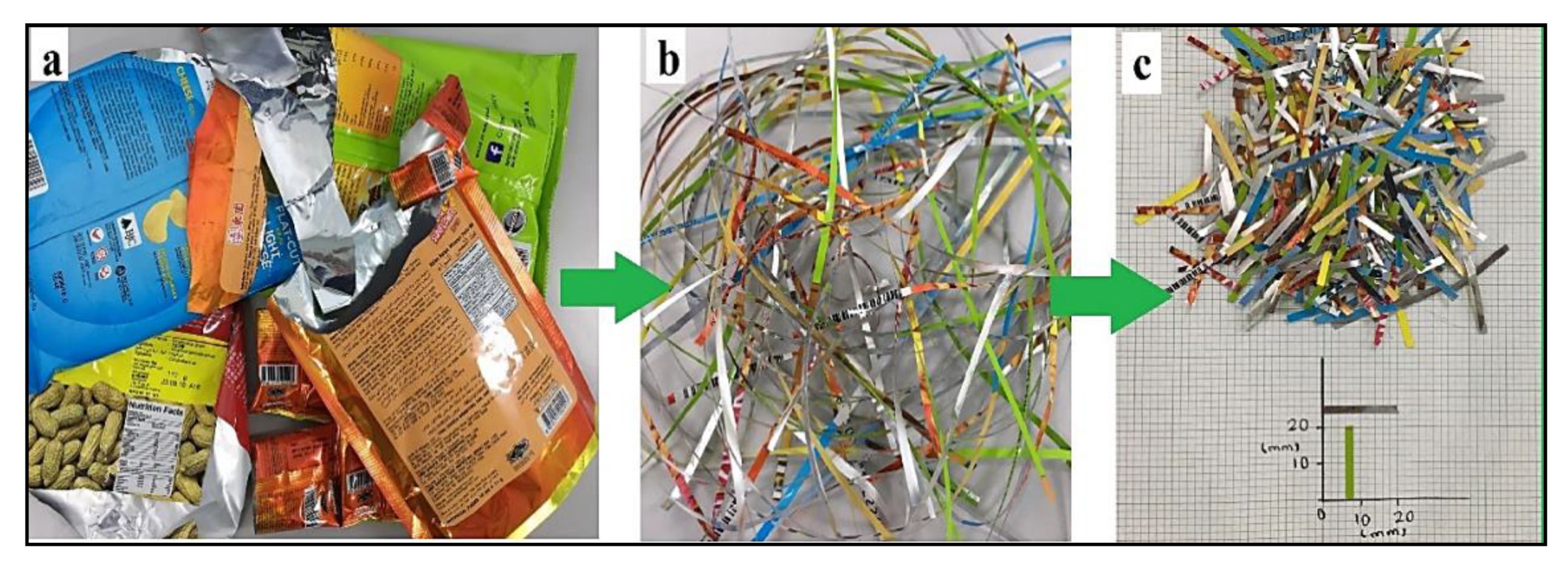

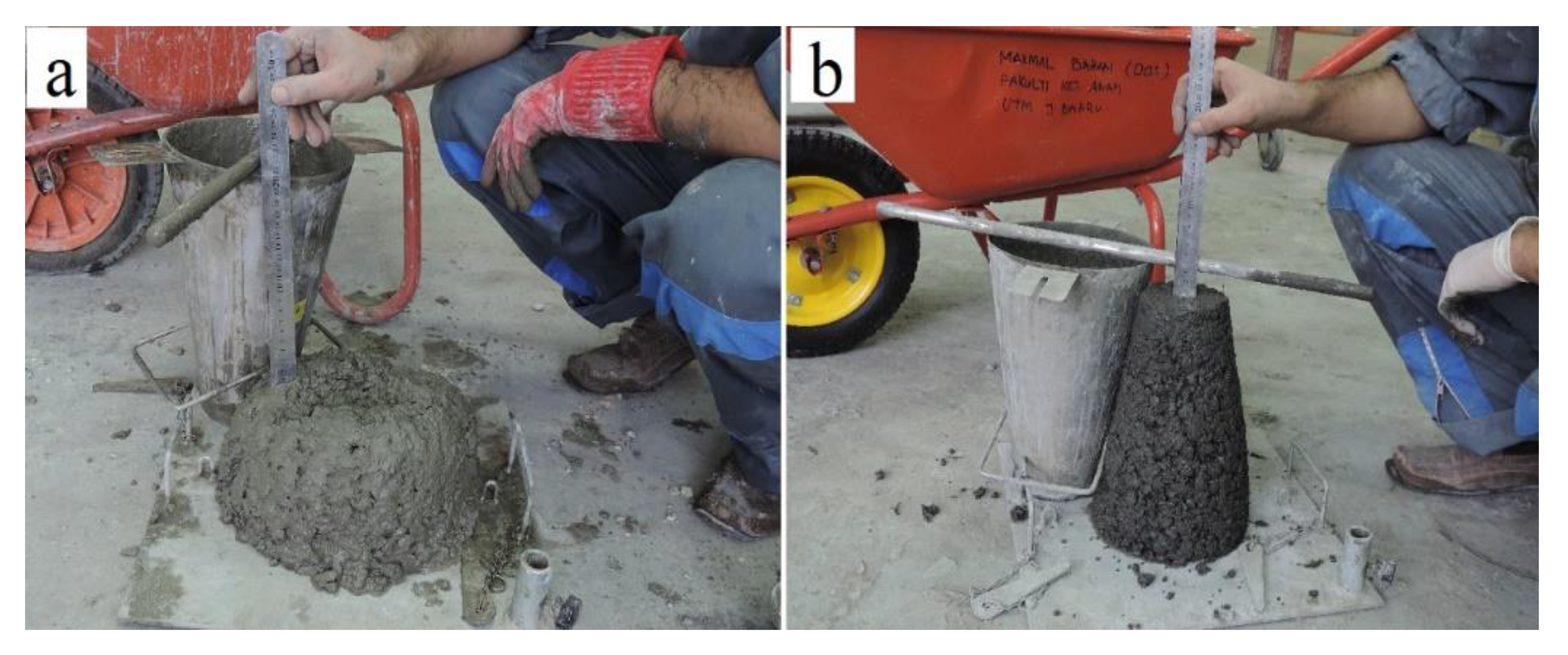
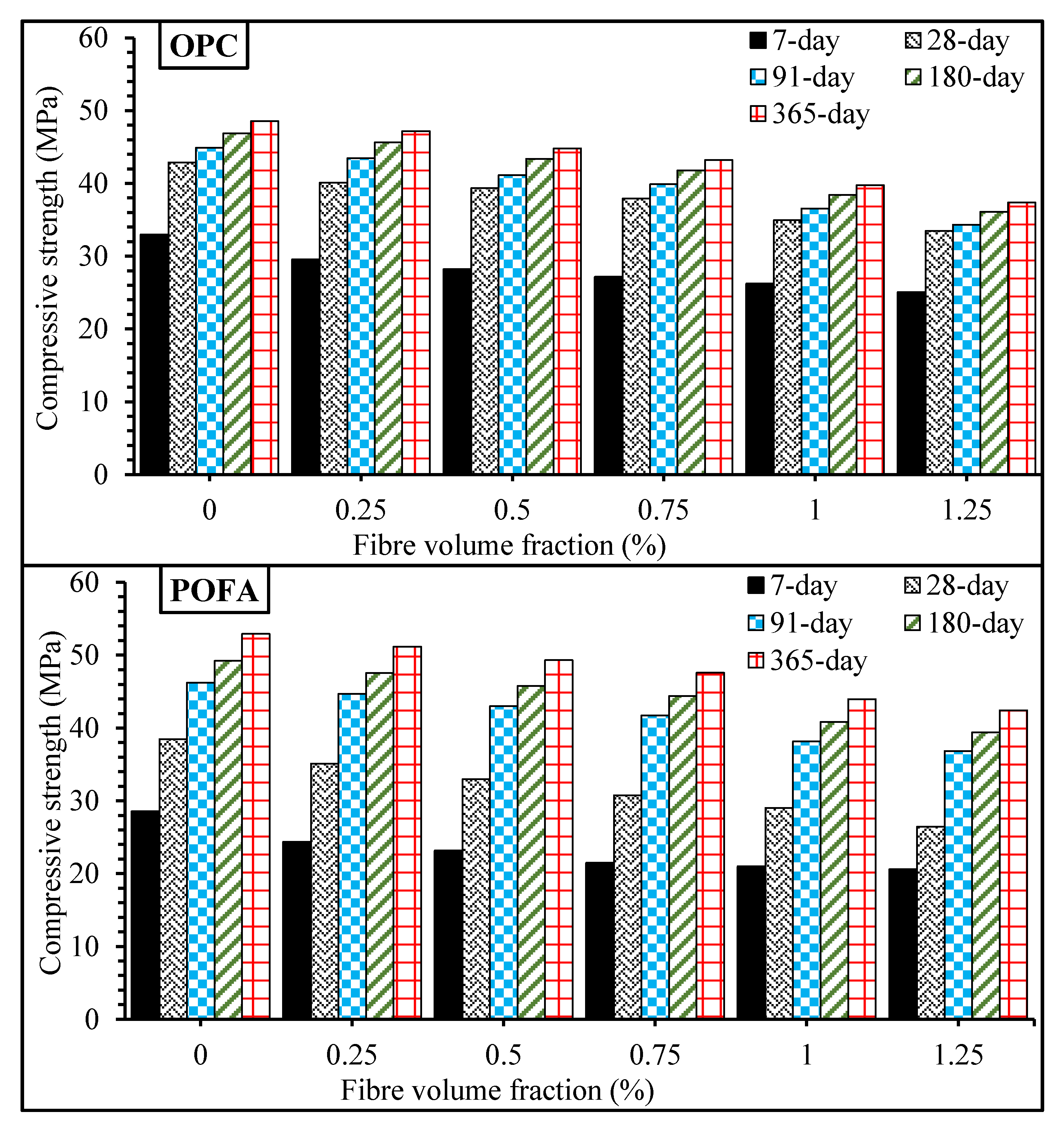
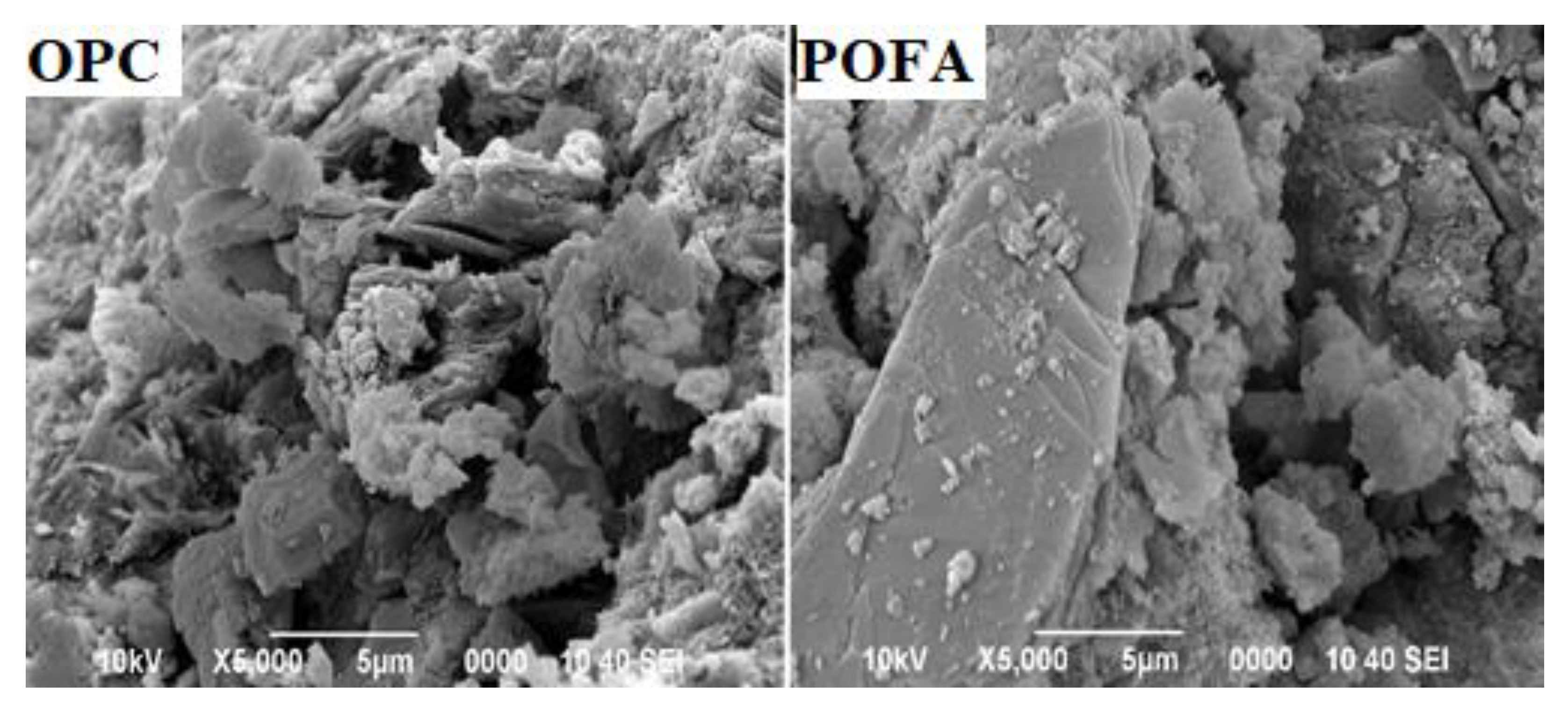

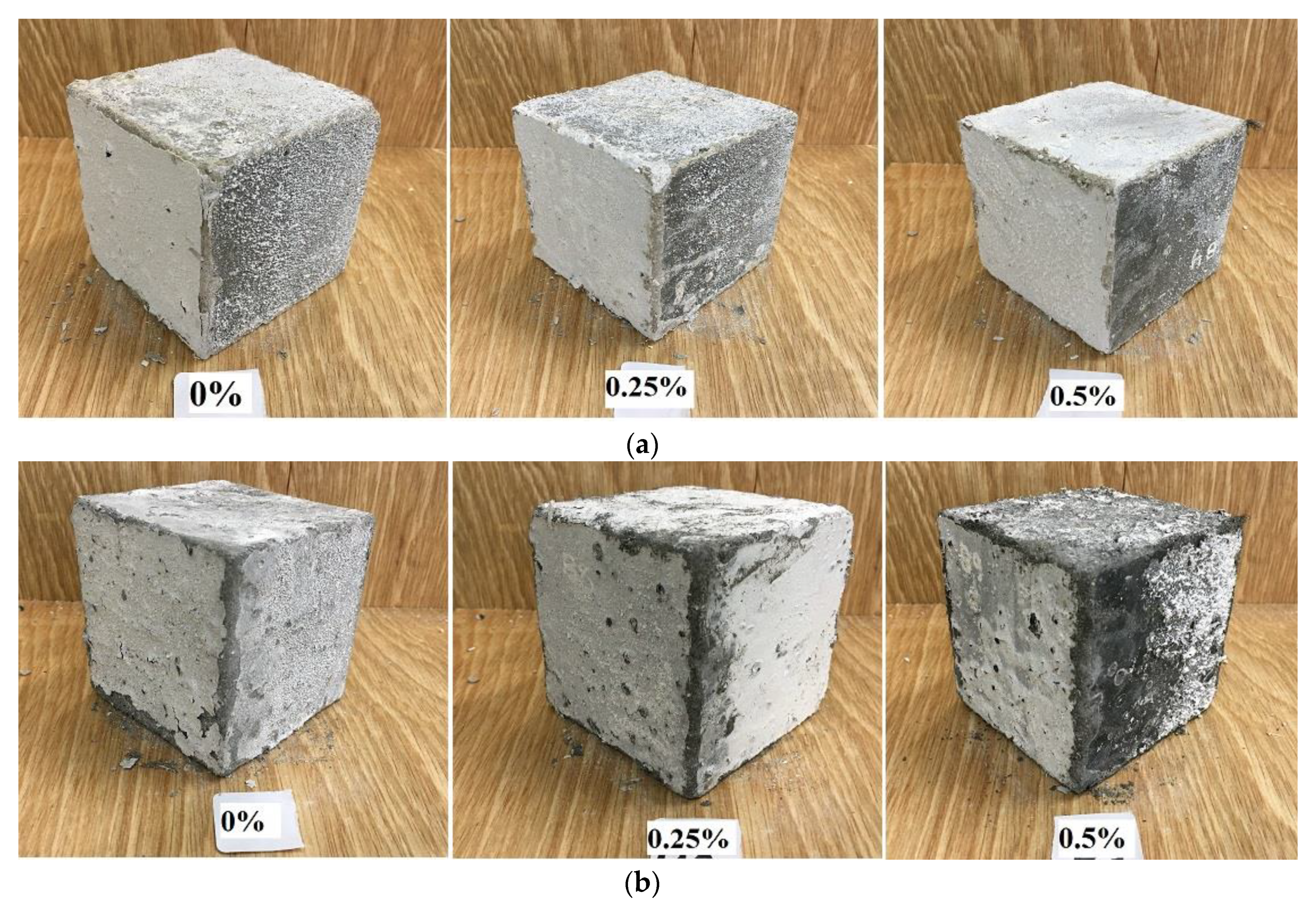
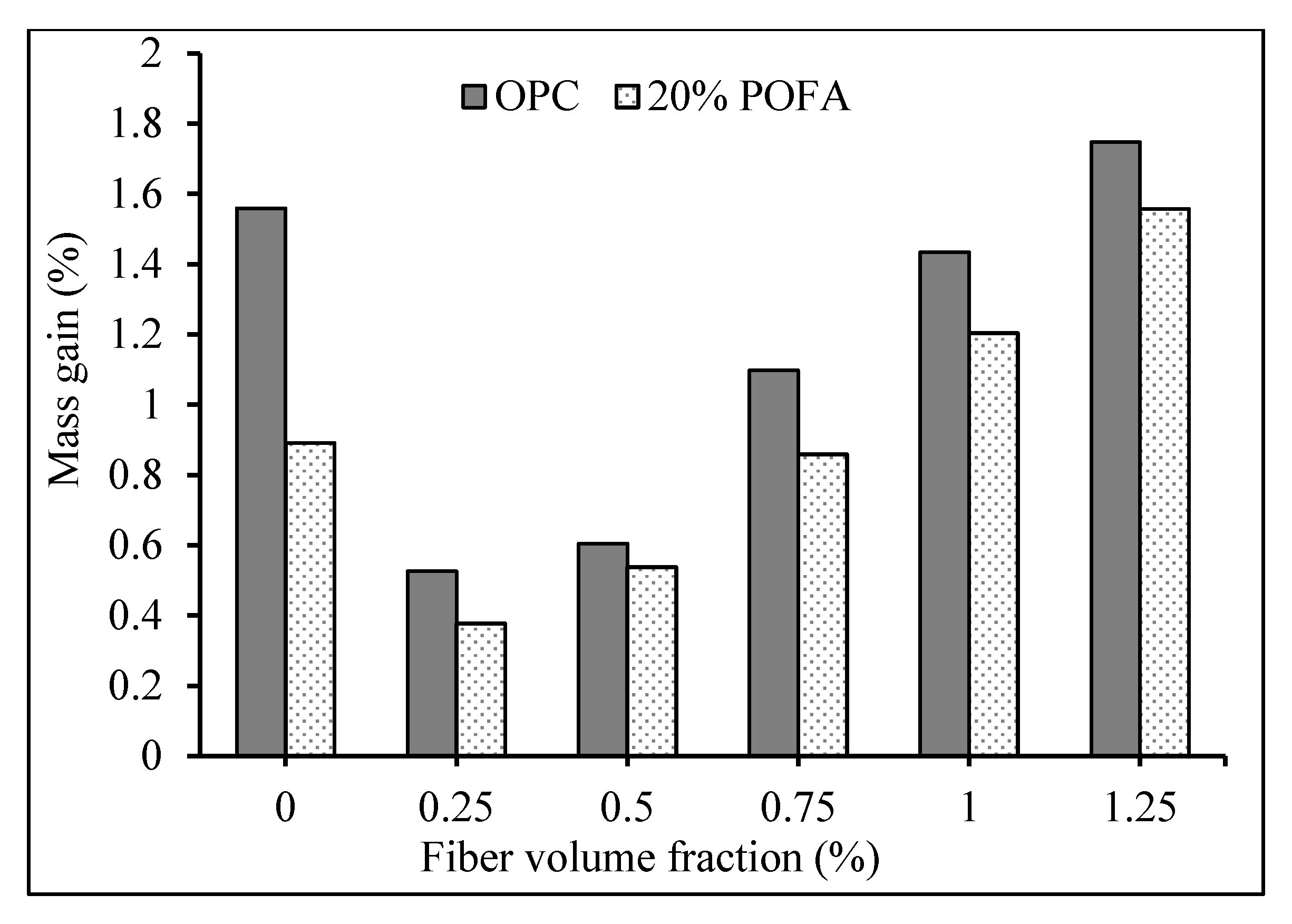

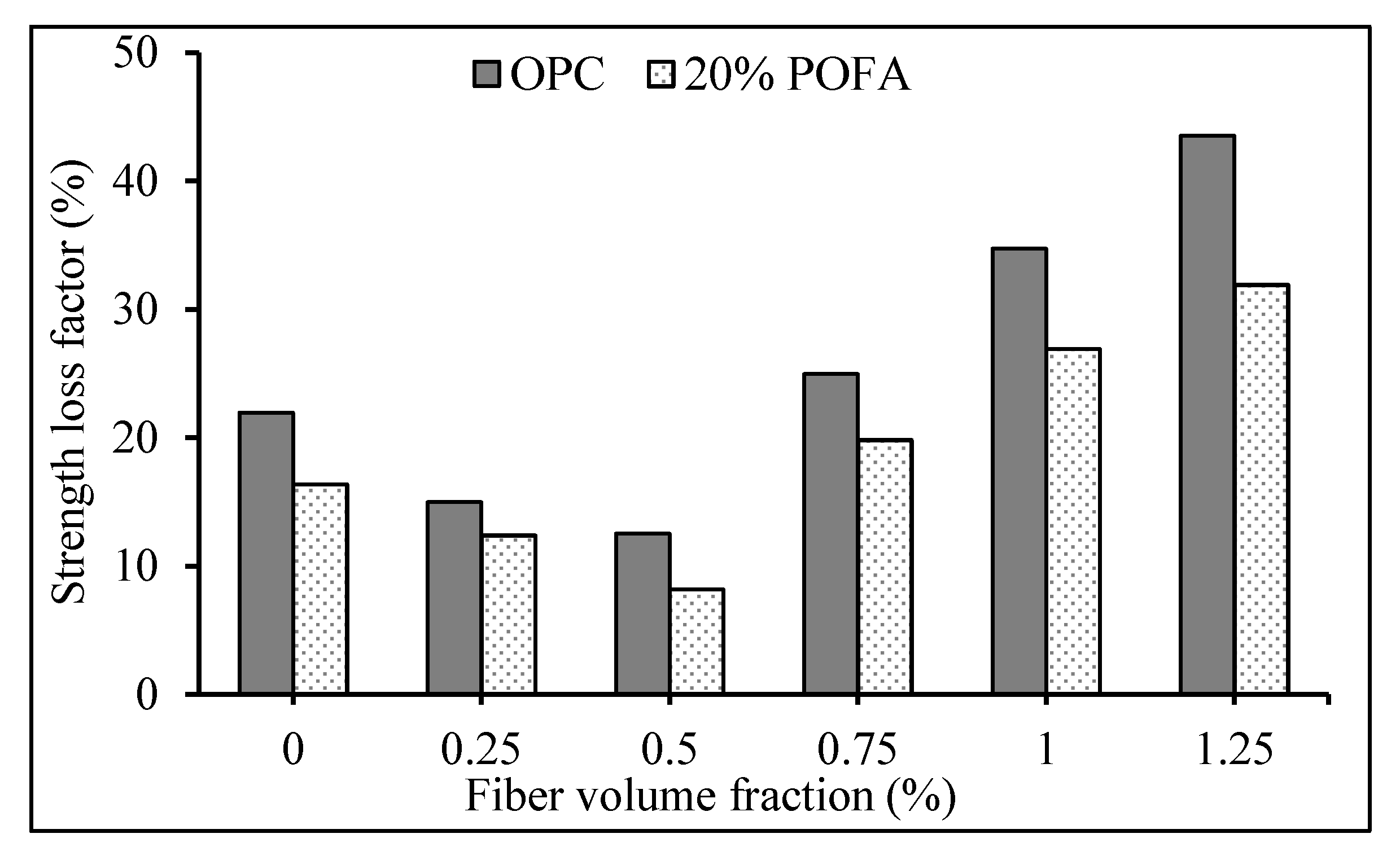
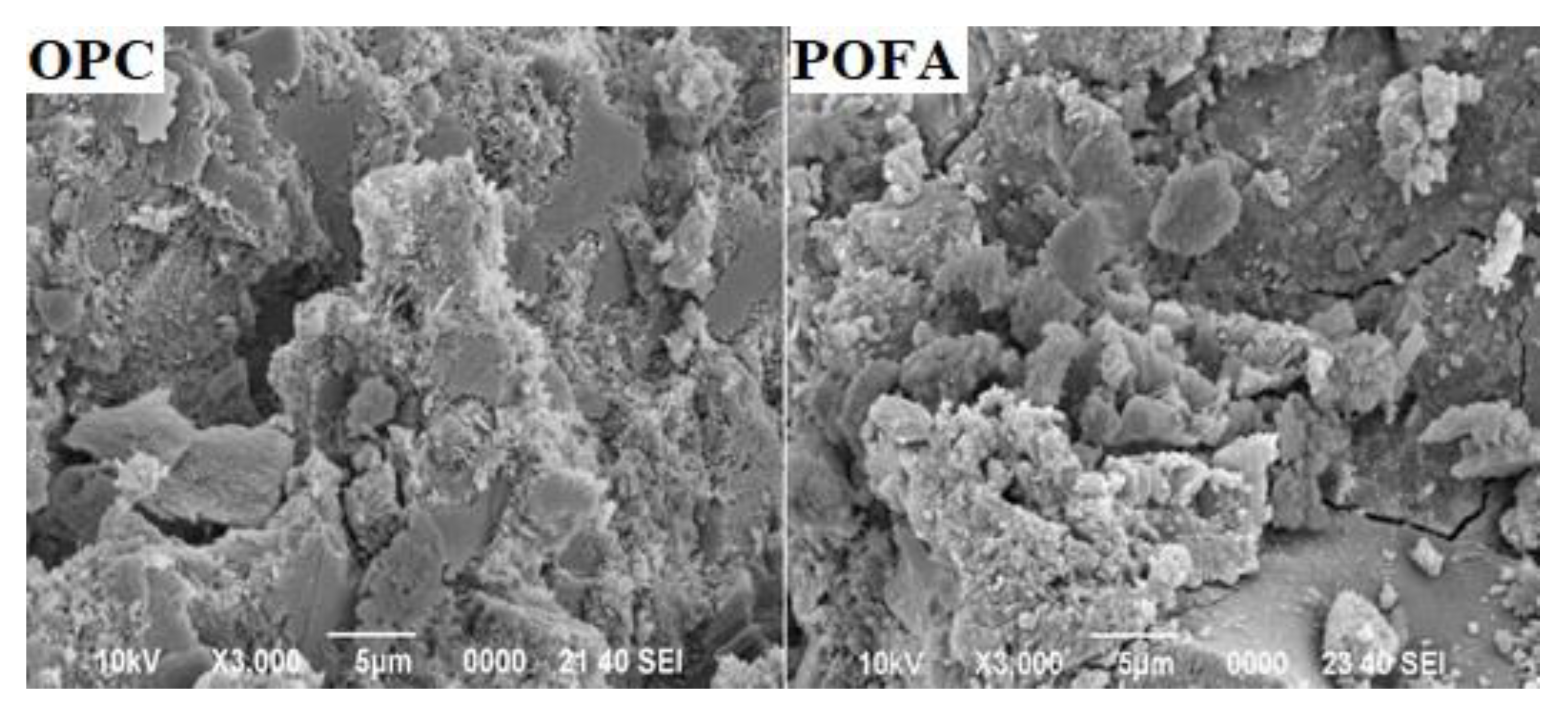
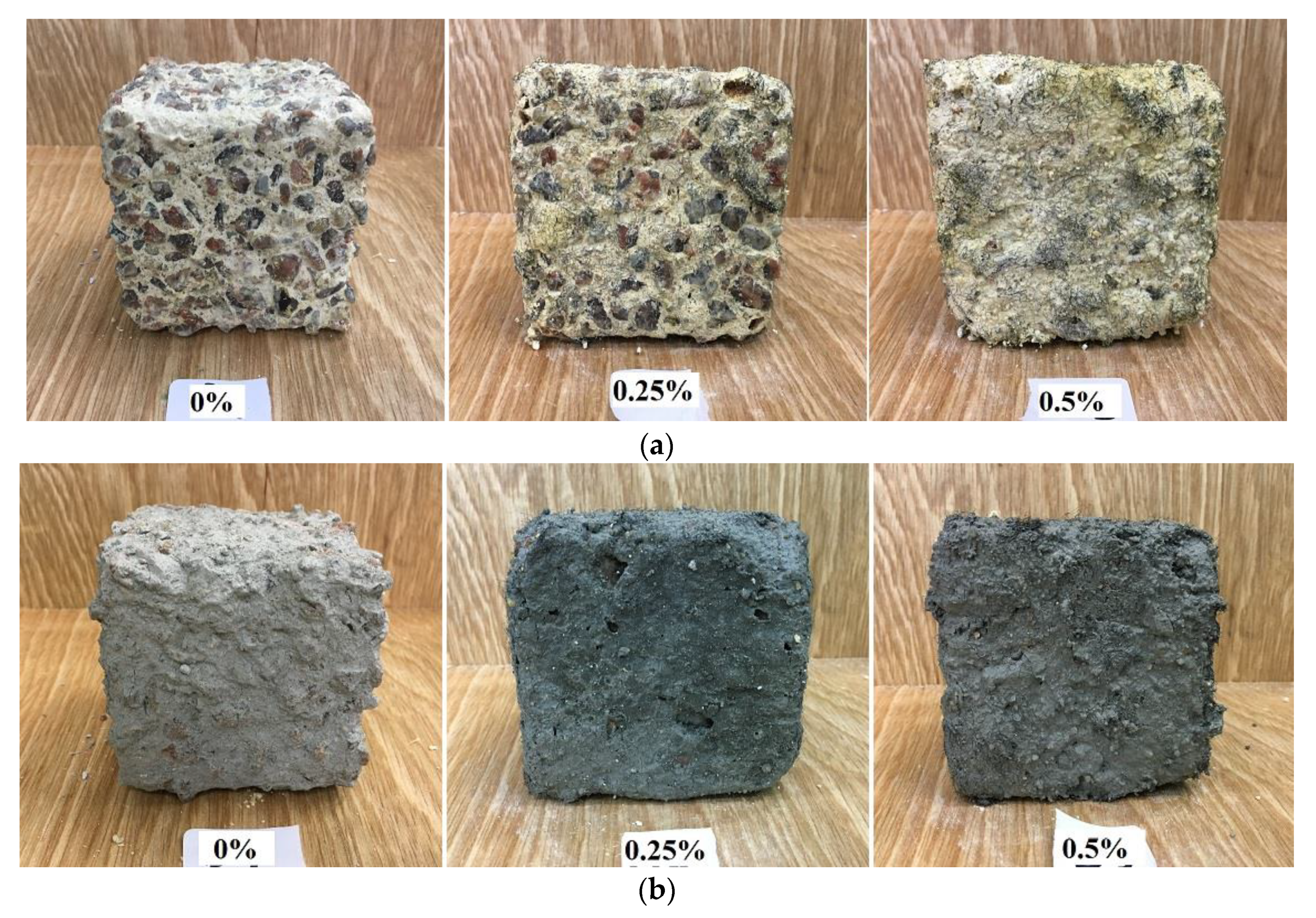
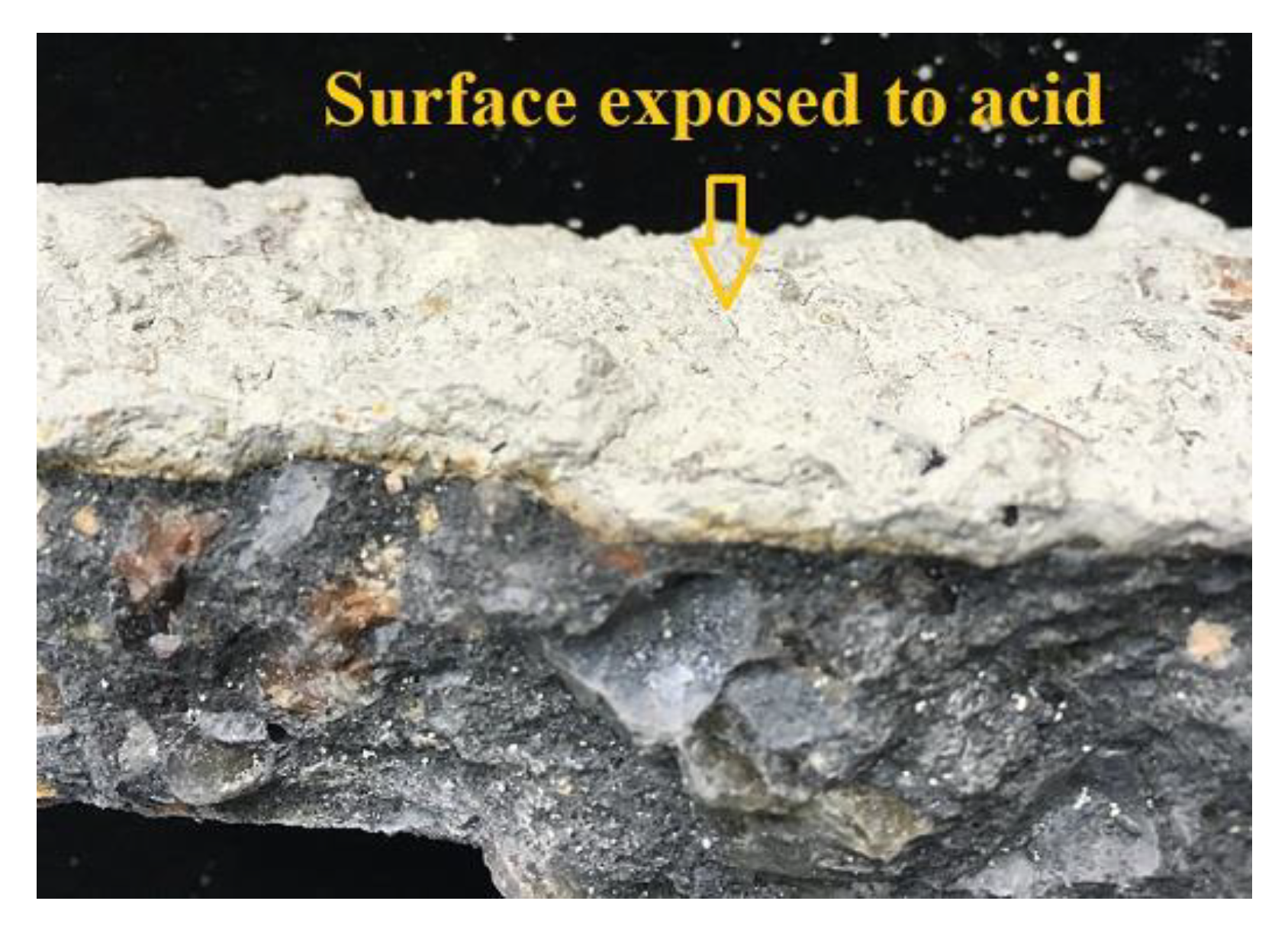

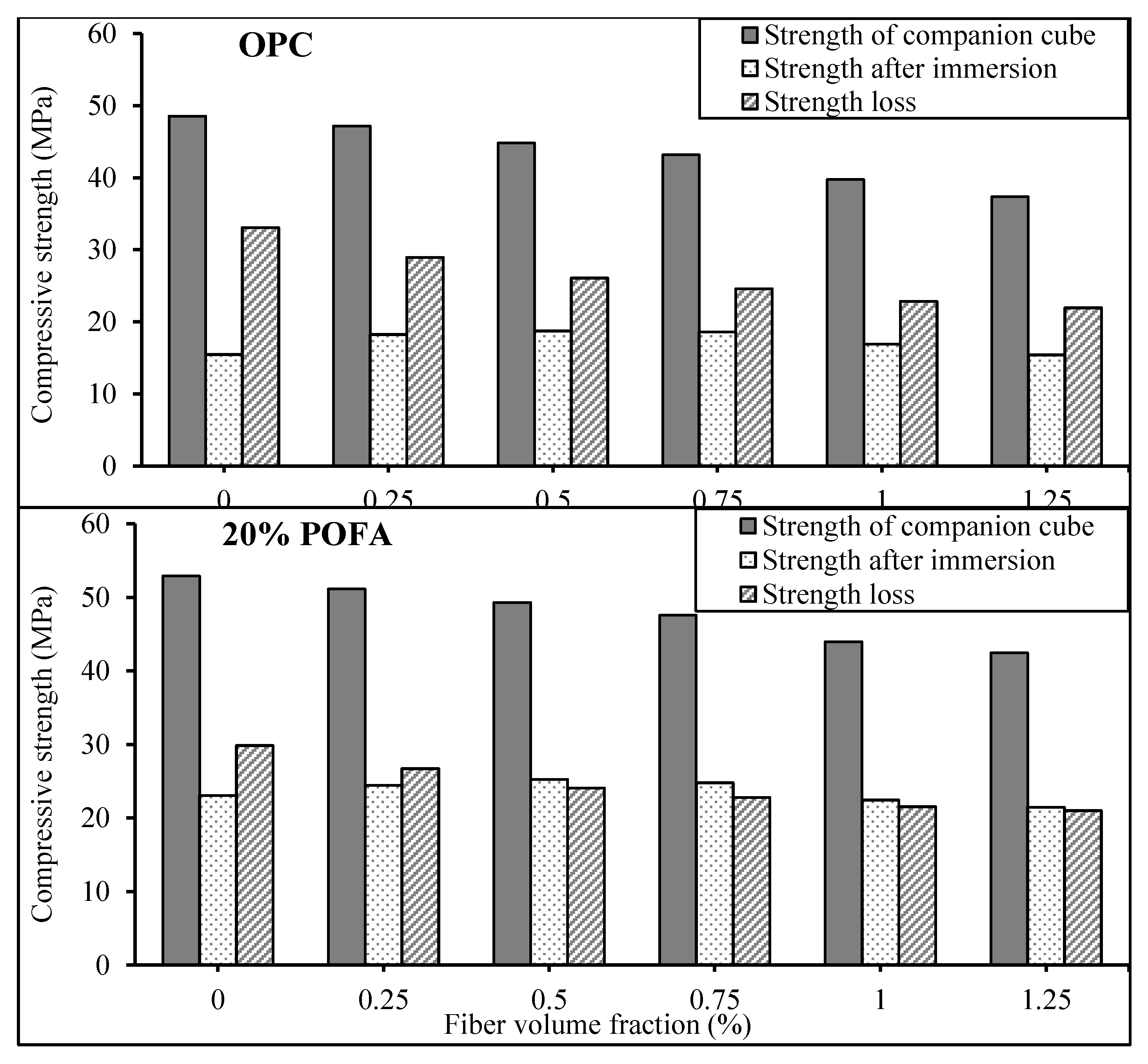

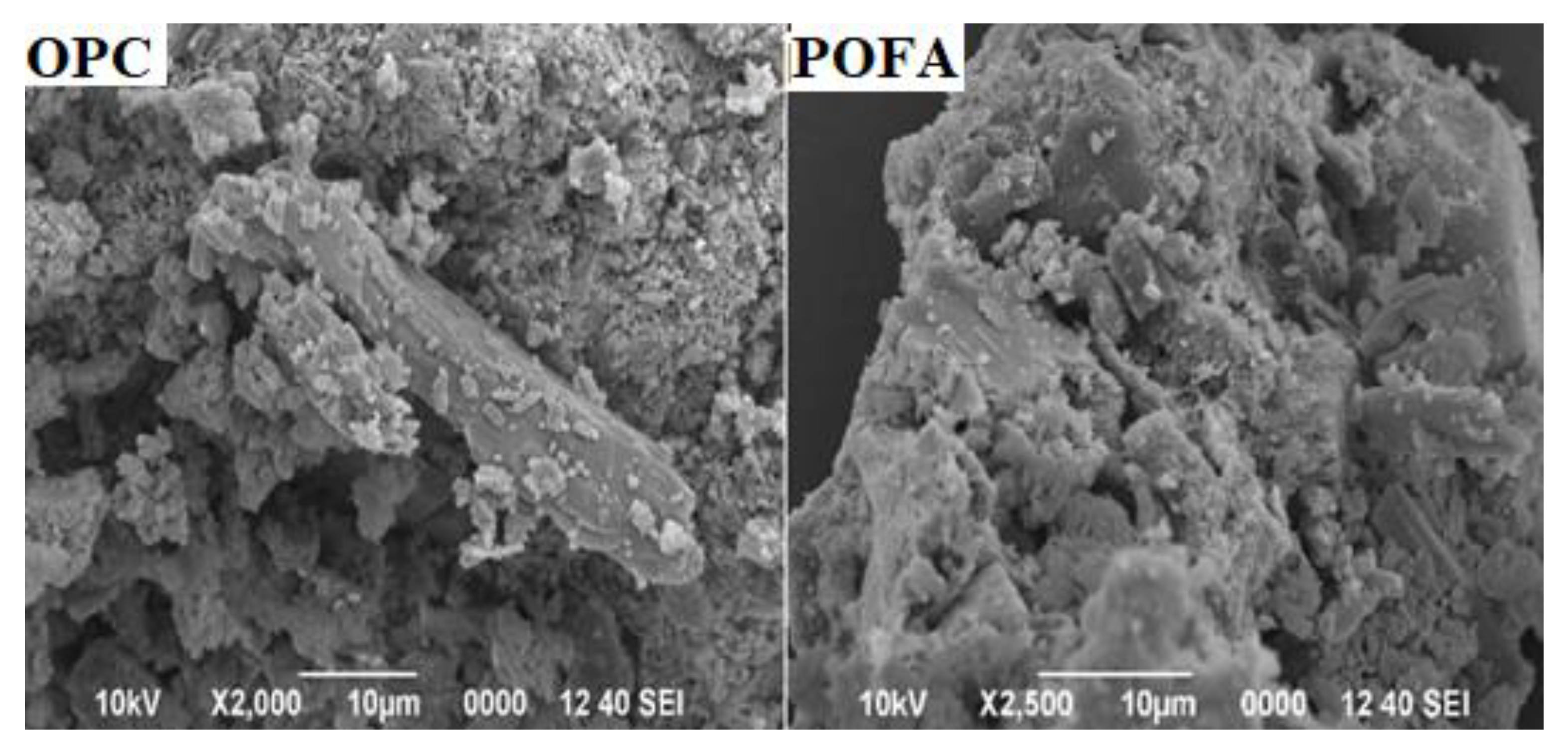
| Material | Physical Properties | Chemical Composition (%) | ||||||||
|---|---|---|---|---|---|---|---|---|---|---|
| Specific Gravity | Blaine Fineness (cm2/g) | SiO2 | Al2O3 | Fe2O3 | CaO | MgO | K2O | SO3 | LOI * | |
| OPC | 3.15 | 3990 | 20.3 | 5.3 | 4.21 | 62.5 | 1.53 | 0.005 | 2.13 | 2.35 |
| POFA | 2.42 | 4930 | 62.7 | 4.8 | 8.14 | 5.8 | 3.54 | 9.07 | 1.17 | 6.28 |
| Resin Type | Plastic Type | Size (W * L) (mm) | Density Range (kg/m3) | Thickness (mm) | Tensile Strength (MPa) | Elongation (%) |
|---|---|---|---|---|---|---|
| Polypropylene | LDPE | 2 * 20 | 0.915–0.945 | 0.07 | 600 | 8–10 |
| Mix | Cement (kg/m3) | POFA (kg/m3) | Water (kg/m3) | Fine Aggregate (kg/m3) | Coarse Aggregate (kg/m3) | WMPF (%) |
|---|---|---|---|---|---|---|
| B1 | 445 | - | 215 | 830 | 860 | 0.0 |
| B2 | 445 | - | 215 | 830 | 860 | 0.25 |
| B3 | 445 | - | 215 | 830 | 860 | 0.50 |
| B4 | 445 | - | 215 | 830 | 860 | 0.75 |
| B5 | 445 | - | 215 | 830 | 860 | 1.0 |
| B6 | 445 | - | 215 | 830 | 860 | 1.25 |
| B7 | 356 | 89 | 215 | 830 | 860 | 0.0 |
| B8 | 356 | 89 | 215 | 830 | 860 | 0.25 |
| B9 | 356 | 89 | 215 | 830 | 860 | 0.50 |
| B10 | 356 | 89 | 215 | 830 | 860 | 0.75 |
| B11 | 356 | 89 | 215 | 830 | 860 | 1.0 |
| B12 | 356 | 89 | 215 | 830 | 860 | 1.25 |
| Mix | Surface Texture | Size | Colour | Edge | Shape |
|---|---|---|---|---|---|
| OPC | |||||
| B1 | Slightly deteriorated | Marginally increased | Whitish deposit | Fine cracks | Perfect cube |
| B2 | Smooth | Marginally increased | Whitish deposit | Fine cracks | Perfect cube |
| B3 | Smooth | No change | Whitish deposit | Perfect | Perfect cube |
| POFA | |||||
| B7 | Slightly deteriorated | Marginally increased | Light grey | Fine cracks | Perfect cube |
| B8 | Slightly deteriorated | Marginally increased | Light grey | Fine cracks | Perfect cube |
| B9 | Smooth | No change | Light grey | Perfect | Perfect cube |
© 2020 by the authors. Licensee MDPI, Basel, Switzerland. This article is an open access article distributed under the terms and conditions of the Creative Commons Attribution (CC BY) license (http://creativecommons.org/licenses/by/4.0/).
Share and Cite
Alyousef, R.; Mohammadhosseini, H.; Alrshoudi, F.; Md. Tahir, M.; Alabduljabbar, H.; Mohamed, A.M. Enhanced Performance of Concrete Composites Comprising Waste Metalised Polypropylene Fibres Exposed to Aggressive Environments. Crystals 2020, 10, 696. https://doi.org/10.3390/cryst10080696
Alyousef R, Mohammadhosseini H, Alrshoudi F, Md. Tahir M, Alabduljabbar H, Mohamed AM. Enhanced Performance of Concrete Composites Comprising Waste Metalised Polypropylene Fibres Exposed to Aggressive Environments. Crystals. 2020; 10(8):696. https://doi.org/10.3390/cryst10080696
Chicago/Turabian StyleAlyousef, Rayed, Hossein Mohammadhosseini, Fahed Alrshoudi, Mahmood Md. Tahir, Hisham Alabduljabbar, and Abdeliazim Mustafa Mohamed. 2020. "Enhanced Performance of Concrete Composites Comprising Waste Metalised Polypropylene Fibres Exposed to Aggressive Environments" Crystals 10, no. 8: 696. https://doi.org/10.3390/cryst10080696
APA StyleAlyousef, R., Mohammadhosseini, H., Alrshoudi, F., Md. Tahir, M., Alabduljabbar, H., & Mohamed, A. M. (2020). Enhanced Performance of Concrete Composites Comprising Waste Metalised Polypropylene Fibres Exposed to Aggressive Environments. Crystals, 10(8), 696. https://doi.org/10.3390/cryst10080696




